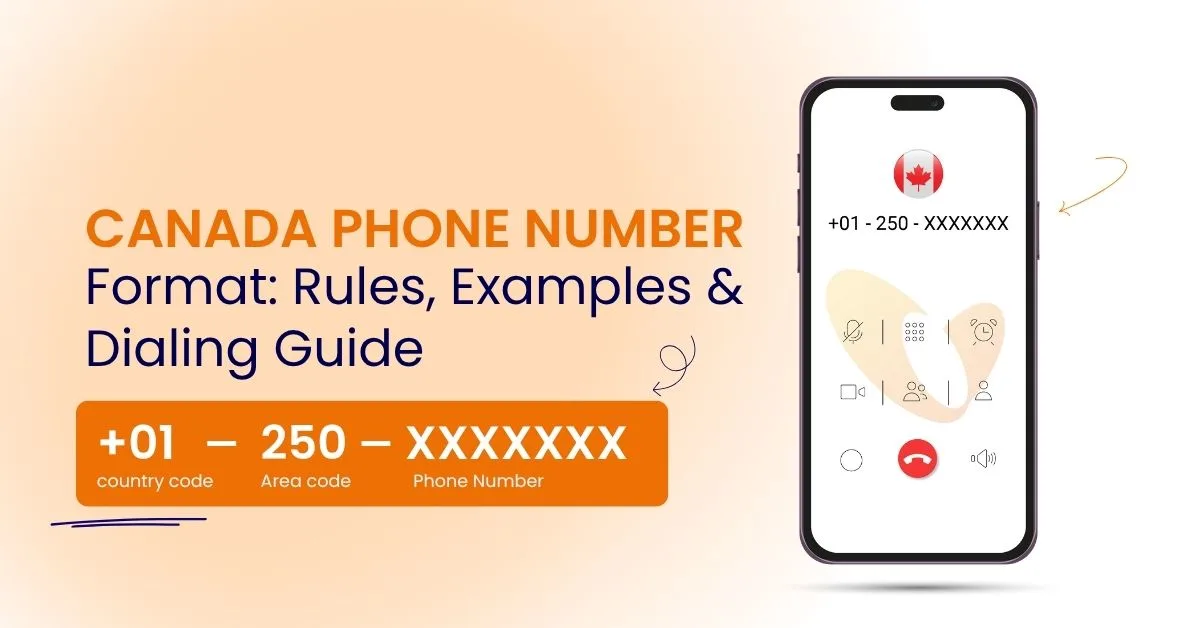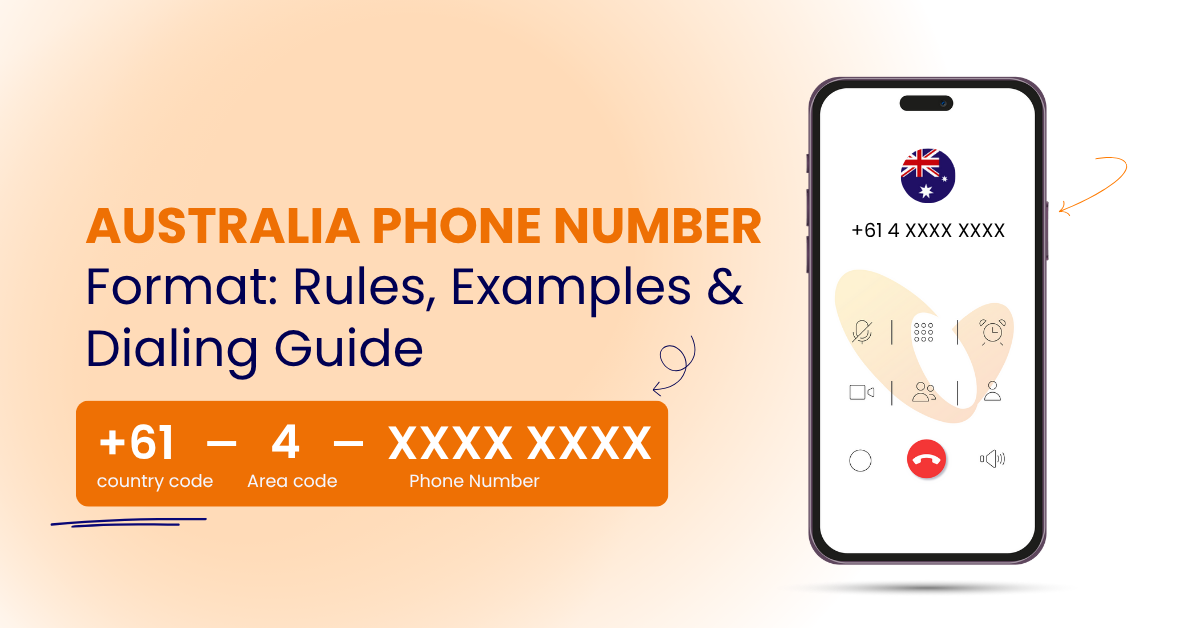Germany Phone Number Format: Simple Guide for 2025

6 min read
Table of Contents
Germany uses many types of phone numbers across mobile phones, landline phones, toll-free lines, and service lines. These numbers often appear in different styles across websites, forms, and customer systems. Some numbers include brackets. Some use dashes or dots. Some show only the local number without Germany’s country code. These differences lead to confusion and failed calls.
A simple and clear German phone number format avoids these problems. It creates one reliable structure that works for mobile numbers, landline numbers, virtual numbers, toll-free numbers, and emergency phone numbers. It also helps people in other countries call Germany without errors. A standard format supports CRMs, VoIP tools, call center platforms, and automated dialing systems.
This guide explains the German phone number format clearly and easily. It covers Germany’s country code, mobile prefixes, geographic area codes, landline phone numbers, toll-free numbers, emergency numbers, and the correct international format. It also shows how to store German phone numbers correctly inside CRMs and cloud communication tools.
Vitel Global helps companies use the correct Germany phone number format to improve routing, reduce wrong numbers, and support smooth communication across regions.
Why a Clear Germany Phone Number Format Matters
German phone numbers often appear in different forms online. Some numbers show long dashes. Others show brackets around the area code. These variations confuse systems that depend on accurate phone numbers. A small formatting mistake can break routing or lead to a wrong number.
A clean German phone number format helps businesses:
- Reach German customers
- Support international calls
- Reduce wrong numbers
- Protect CRM accuracy
- Improve routing across VoIP systems
- Use virtual phone numbers correctly
- Avoid duplicates inside CRMs
- Serve local customers with trust
A stable format is important for global teams, especially when calling Germany from other countries or using cloud-based calling tools.
How to Dial Germany Phone Numbers Correctly
To call Germany from another country, the caller needs a simple sequence. Every international call starts with the international access code, then +49, which is Germany’s country code. After this, the caller enters the German area code or mobile prefix without the leading zero, followed by the subscriber number.
Domestic format:
030 XXXXXXXX (Berlin)
International format:
+49 30 XXXXXXXX
This pattern works across mobile phones, VoIP platforms, international calling tools, and cloud telephony systems. It ensures that calls reach the correct German number without failure.
Germany Cell Phone Number Format Explained Simply
German mobile phone numbers follow a clear structure. Every mobile number inside Germany begins with 01. These two digits represent German mobile prefixes. After this prefix, the mobile subscriber number follows. The total length may change by one digit, but the pattern stays simple.
Domestic format:
0151 XXXXXXXX
0176 XXXXXXXX
International format:
+49 151 XXXXXXXX
+49 176 XXXXXXXX
The leading 0 must be removed for international calls. Keeping the zero causes failed routing and prevents calls from reaching German mobile phone numbers. This rule applies to all mobile networks in Germany.
German mobile numbers work across different mobile networks, but the structure stays the same. This makes the German cell phone number format easy to apply across systems.
Germany Landline Phone Number Format and Area Codes
Germany uses geographic area codes, also called Vorwahlen. These area codes help identify cities and towns. German landline phone numbers begin with 0 inside Germany. The zero is removed when the number is used in international format.
Major area codes:
- Berlin – 030
- Hamburg – 040
- Munich – 089
- Cologne – 0221
- Frankfurt – 069
- Stuttgart – 0711
Example:
Domestic: 089 XXXXXXXX
International: +49 89 XXXXXXXX
Some cities use two-digit area codes. Some towns use three-digit or four-digit area codes. The Federal Network Agency manages these area codes and ensures that numbers in Germany follow one national plan.
Landline phone numbers follow this structure:
0 + area code + subscriber number
International structure:
+49 + area code (without 0) + subscriber number
This format supports landline phones, office numbers, and all local German phone numbers.
Germany’s Telephone Numbering Plan Explained Clearly
Germany uses a national telephone numbering plan that defines how phone numbers work across the country. It guides mobile phone numbers, landline numbers, toll-free numbers, emergency numbers, and special service numbers.
The numbering plan covers:
- Germany cell phone number format
- German landline phone number structure
- Mobile prefixes
- Geographic area codes
- Toll-free numbers (0800)
- Service numbers (0180)
- Emergency numbers (110 and 112)
- International formats
- Virtual phone numbers
All German phone numbers follow this structure: country code, area code or mobile prefix, and subscriber number. This helps carriers, VoIP systems, and government offices maintain a stable telephone network.
Germany Mobile Prefixes and Mobile Networks
German mobile phone numbers use several mobile prefixes. These prefixes identify the original assigned network, even though customers can switch providers without changing their numbers.
Common German mobile prefixes include 0151, 0160, 0170, 0171, 0172, 0173, 0174, 0175, 0176, and 0179. These prefixes help identify German mobile networks and are used across all major carriers in Germany.
Example:
Domestic: 0176 XXXXXXXX
International: +49 176 XXXXXXXX
These prefixes help systems recognize that the number is a German mobile phone number. They also support routing through mobile networks and VoIP platforms.
How International Callers Reach Germany
Calling Germany from other countries requires a clear sequence. The caller begins with the exit code, then dials +49, then enters the German area code or mobile prefix without the zero, followed by the subscriber number.
Example:
Domestic mobile: 0152 XXXXXXX
International: +49 152 XXXXXXX
This format works across Europe, Asia, the United States, and all major telephone networks. It is also the structure used for international dialing inside cloud communication tools.
Storing German Phone Numbers in CRMs and VoIP Systems
CRMs and VoIP systems need a clean, simple phone number format. Using extra symbols, brackets, or long chains can lead to errors. The correct Germany phone number format inside CRMs uses:
- +49 at the start
- No leading zero
- No brackets
- No slashes
- Area code included
- Subscriber number added after
Correct example:
+49 170 XXXXXXX
This clean structure supports caller ID, search functions, call routing, call recording, and customer matching.
Germany Toll-Free Numbers and Service Lines
Germany uses non-geographic telephone numbers for businesses and national services. These numbers work across Germany and do not depend on local area codes.
Common service formats:
- 0800 numbers – toll-free
- 0180 numbers – shared cost service numbers
- Premium rate service numbers
Example:
0800 XXXXXXX
German toll-free numbers help businesses support customers without charging them for calls.
Germany Virtual Phone Numbers for Business Presence
Many companies outside Germany use virtual phone numbers to reach German customers. A virtual phone number appears as a German number while routing calls to teams anywhere in the world. It follows the same German phone number format as regular numbers.
Virtual numbers help companies:
- Reach German customers
- Build trust
- Handle incoming calls
- Support remote teams
- Maintain a local presence
- Run national campaigns
- Record calls cleanly
Vitel Global offers virtual German phone numbers to businesses that want to expand into the German market.
Germany Phone Number Format Examples for Business
Berlin landline:
030 XXXXXXXX → +49 30 XXXXXXXX
Munich landline:
089 XXXXXXXX → +49 89 XXXXXXXX
Hamburg landline:
040 XXXXXXXX → +49 40 XXXXXXXX
German mobile number:
0176 XXXXXXXX → +49 176 XXXXXXXX
German toll-free:
0800 XXXXXXX
These examples follow the correct format and support local and international communication.
Emergency Numbers in Germany
Germany uses short emergency phone numbers for urgent help.
110 – Police
112 – Fire and ambulance
112 is the European emergency number used across the European Union. It offers fast access to emergency services and medical support.
These numbers do not follow the standard German phone number format.
Why Correct Formatting Matters for VoIP and Cloud Calling
VoIP systems and cloud communication tools depend on correct number formatting. A wrong Germany phone number format can block calls, break routing, or create duplicate entries in a CRM. Clean formatting improves reliability.
Correct formatting supports:
- Call routing
- Caller ID matching
- CRM accuracy
- Call recording
- Customer support
- Local presence
- International calls
Vitel Global helps companies normalize German phone numbers across all communication tools.
The Vitel Global Advantage for Germany Communication
Vitel Global supports companies that want simple and accurate communication in Germany. Businesses gain:
- German virtual numbers
- CRM-integrated calling
- AI-based call routing
- Clean formatting support
- Easy setup
- Reliable service numbers
Companies use Vitel Global to improve communication with German customers across landline numbers, mobile numbers, and virtual phone numbers.
Germany Phone Numbers Made Simple for Your Business
Get clean and accurate Germany phone number formatting for smooth calling and stable routing across all your business systems.
Frequently Asked Questions
1. Does +49 replace the zero in German phone numbers?
Yes. +49 replaces the leading zero in all German phone numbers. Example: 0176 becomes +49 176. Removing the zero helps VoIP systems, CRMs, and international callers route German numbers correctly without errors or failed attempts.
2. How do I format a German phone number for international calls?
Use +49, remove the leading zero, add the area code or mobile prefix, then add the subscriber number. Keep the number simple and free of symbols. This structure supports international calls and cloud communication platforms used by global businesses.
3. How many digits do German mobile numbers have?
German mobile numbers usually contain ten or eleven digits when the prefix and subscriber number are combined. The domestic version uses 01. The international version begins with +49. This helps callers reach German mobile numbers with stable routing.
4. Is +49 Germany’s official country code?
Yes. +49 is the official country code for Germany. It replaces the leading zero used in Germany. Using +49 ensures correct routing across mobile networks, VoIP systems, CRMs, and international calling platforms that dial German numbers.
5. What are the major German area codes?
Major German area codes include 030 for Berlin, 089 for Munich, 040 for Hamburg, and 0221 for Cologne. In international format, remove the zero and start with +49. This supports reliable calling from other countries and cloud systems.
6. What are Germany’s toll-free numbers?
Germany uses 0800 numbers as toll-free lines. These numbers allow customers to call businesses without cost. They support national services, customer care, and government offices. Toll-free numbers do not rely on any specific geographic area code.
7. How do I store German numbers cleanly in CRMs?
Store numbers in +49 format without brackets or extra symbols. Remove the leading zero and include the full area code or mobile prefix. This prevents duplicates and supports clear routing, caller matching, and communication across cloud-based platforms.
8. What benefits does VoIP offer for calling Germany?
VoIP improves routing, lowers communication costs, supports virtual numbers, and integrates with CRMs. It also improves caller ID accuracy and call recording. VoIP systems use the correct German phone number format to ensure stable calling across networks.
Published: November 20th, 2025
Subscribe to Our Latest Updates
Get monthly product and feature updates, the latest industry news, and more!




